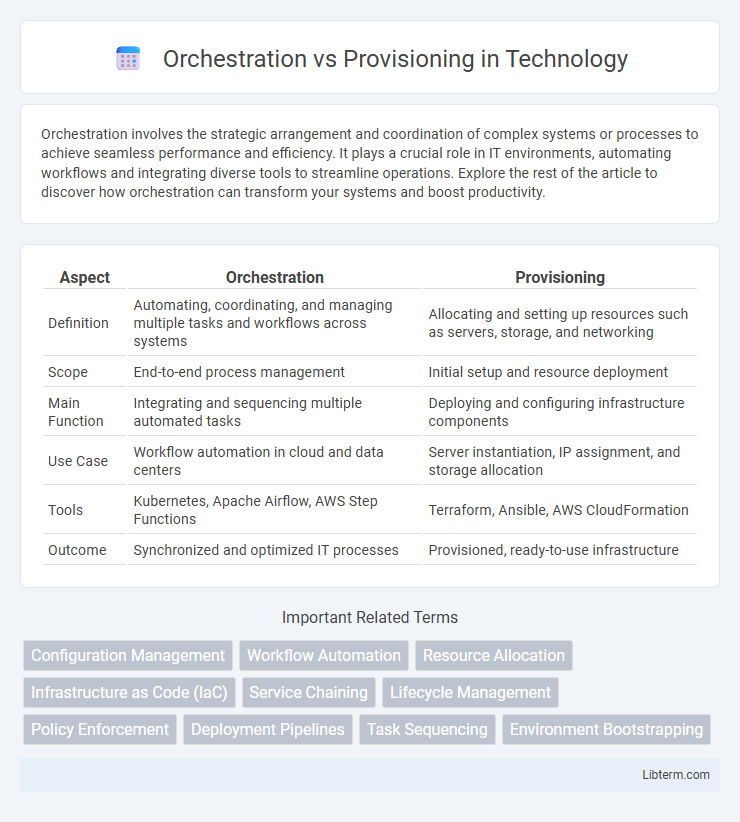Orchestration involves the strategic arrangement and coordination of complex systems or processes to achieve seamless performance and efficiency. It plays a crucial role in IT environments, automating workflows and integrating diverse tools to streamline operations. Explore the rest of the article to discover how orchestration can transform your systems and boost productivity.
Table of Comparison
| Aspect | Orchestration | Provisioning |
|---|---|---|
| Definition | Automating, coordinating, and managing multiple tasks and workflows across systems | Allocating and setting up resources such as servers, storage, and networking |
| Scope | End-to-end process management | Initial setup and resource deployment |
| Main Function | Integrating and sequencing multiple automated tasks | Deploying and configuring infrastructure components |
| Use Case | Workflow automation in cloud and data centers | Server instantiation, IP assignment, and storage allocation |
| Tools | Kubernetes, Apache Airflow, AWS Step Functions | Terraform, Ansible, AWS CloudFormation |
| Outcome | Synchronized and optimized IT processes | Provisioned, ready-to-use infrastructure |
Introduction to Orchestration and Provisioning
Orchestration automates the coordination and management of complex workflows across multiple systems and services, streamlining processes to ensure efficient operation. Provisioning involves the automated setup and configuration of IT resources such as servers, storage, and networks to prepare environments for application deployment. Both orchestration and provisioning are fundamental in cloud computing and DevOps, enabling scalable, automated infrastructure management.
Defining Orchestration in IT Operations
Orchestration in IT operations refers to the automated arrangement, coordination, and management of complex computer systems, middleware, and services to streamline workflows and improve efficiency. It integrates multiple tasks across various systems, enabling seamless resource allocation and process execution without manual intervention. Unlike provisioning, which involves the initial setup and configuration of resources, orchestration ensures that these resources interact and function cohesively within the IT environment.
What is Provisioning? Key Concepts
Provisioning is the automated process of preparing and equipping IT systems, applications, or networks to function efficiently. Key concepts include resource allocation, configuration management, and access control, enabling rapid deployment of virtual machines, storage, and users. Effective provisioning ensures scalability and consistency, reducing manual errors and accelerating operational readiness.
Core Differences: Orchestration vs Provisioning
Provisioning involves the automated allocation and configuration of individual IT resources such as servers, storage, and networking components. Orchestration coordinates multiple provisioning tasks and workflows to create a seamless, end-to-end IT service deployment process. Core differences lie in provisioning managing specific resource lifecycles, while orchestration integrates and automates complex sequences across various systems and services.
Use Cases for Orchestration
Orchestration automates complex workflows by coordinating multiple automated tasks and systems, making it ideal for large-scale cloud deployment, multi-service application management, and continuous integration/continuous deployment (CI/CD) pipelines. It enables seamless resource allocation, configuration, and service dependencies to optimize efficiency in containerized environments like Kubernetes and hybrid cloud architectures. Use cases include automated service scaling, self-healing infrastructure, and streamlining IT service delivery processes.
Provisioning in Cloud Environments
Provisioning in cloud environments involves the automated allocation and configuration of resources such as virtual machines, storage, and networks to meet specific workload demands. It ensures rapid deployment and scaling by leveraging predefined templates and APIs, reducing manual intervention and operational errors. Efficient provisioning optimizes resource utilization and supports dynamic cloud infrastructures by seamlessly integrating with orchestration tools.
Benefits of Effective Orchestration
Effective orchestration streamlines complex workflows by automating the coordination of multiple IT services, reducing human error and operational costs. It enhances resource utilization and improves scalability by dynamically allocating resources based on real-time demand. Organizations benefit from faster deployment times and increased agility, enabling more responsive and efficient management of IT environments.
Challenges in Provisioning Processes
Provisioning processes often face challenges such as resource misallocation, delays in service delivery, and difficulties in integrating diverse systems. Managing dynamic resource requirements requires automation tools with high accuracy to prevent errors and downtime. Ensuring compliance with security policies during provisioning also adds complexity to the overall management workflow.
Integrating Orchestration and Provisioning
Integrating orchestration and provisioning enhances cloud infrastructure management by automating resource allocation and workflow execution simultaneously, reducing operational complexity and improving scalability. Orchestration coordinates multiple provisioning tasks, enabling seamless deployment and configuration of virtual machines, containers, and network services in a cohesive environment. Effective integration leverages APIs and infrastructure-as-code tools, ensuring consistent, repeatable, and efficient IT service delivery across hybrid and multi-cloud platforms.
Choosing the Right Approach for Your Infrastructure
Selecting the right approach between orchestration and provisioning depends on your infrastructure's complexity and automation goals. Provisioning focuses on the initial setup of resources such as virtual machines, networking, and storage, while orchestration manages the coordination and automation of these resources for ongoing operations. For dynamic, scalable environments requiring seamless integration and workflow automation, orchestration offers significant advantages over basic provisioning.
Orchestration Infographic

 libterm.com
libterm.com